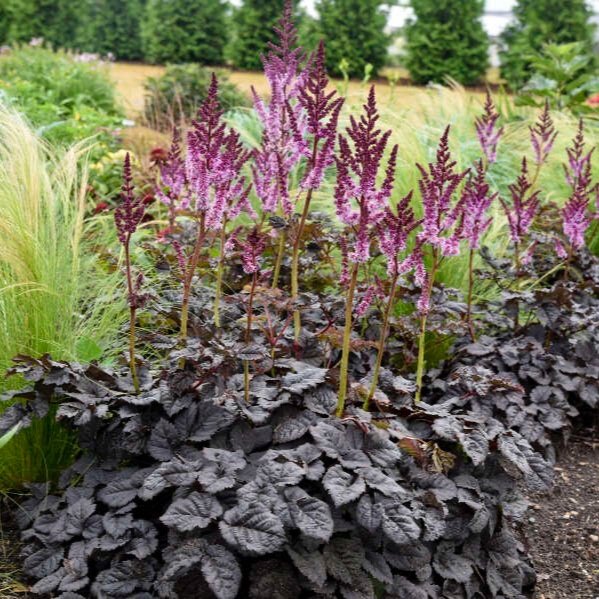A Black Foliage Dahlia
Cover image of Dahlia Black Forest Ruby courtesy of All-America Selections, All-AmericaSelections.org
Meet Dahlia ‘Black Forest Ruby’
Black foliage dahlias make a bold and eye-catching focal point in the landscape.
Dahlia ‘Black Forest Ruby’ may have a dark and mysterious name, but rest assured—it’s here to slay in the garden, not in a crime novel! With its deep black foliage and vibrant ruby-red blooms, this dahlia is a true showstopper in any garden.
This striking variety produces an abundance of double to semi-double flowers, creating a rich contrast against deep black leaves.
Supported by sturdy, upright stems that won’t flop, Dahlia Black Forest Ruby maintains a tidy and polished appearance throughout the season. Its impressive disease resistance makes it both reliable and beautiful!
Black foliage dahlias like this one add a dramatic touch to flower beds, borders, and containers, making them a favorite for bold, eye-catching designs.
Dahlia Black Forest Ruby is a 2025 All-America Selections winner, earning this recognition from the non-profit plant trialing organization for its outstanding garden performance. To learn more about their work, visit their website.
Let’s take a closer look at how to grow this captivating black foliage dahlia and explore creative ways to incorporate its dark beauty into your landscape.
This blog is reader-supported and contains affiliate links. If you purchase a product using one of these links, I may earn a small commission at no extra cost to you. Thank you for your support!
Dahlia Black Forest Ruby. Image courtesy of All-America Selections, All-AmericaSelections.org
Are Dahlias Perennial?
Dahlias are technically tender perennials, meaning they can survive year after year in the right conditions. They are hardy in USDA zones 9-11, where winters are mild and the soil doesn’t freeze (Don’t know your zone? Take a look at the USDA’s Plant Hardiness Zone map).
In these regions, dahlias can be left in the ground, and they will return each year with their vibrant blooms. However, in the colder zones where winter temperatures drop significantly, dahlias are treated as annuals because their tubers cannot survive freezing soil.
If you're unsure of your hardiness zone, you can visit the USDA Plant Hardiness Zone Map to determine your region. For gardeners in colder zones (8 and below), dahlias can still be enjoyed year after year with a little extra care.
To overwinter dahlias, simply dig up the tubers before a hard freeze and store them in a cool, dry place, and then replant them in the spring.
This simple step ensures that even in harsh winter climates, you can continue growing and enjoying these stunning flowers season after season.
This flexibility makes Dahlia Black Forest Ruby a great choice for a wide range of gardens. Always check plant labels for specific growing recommendations to ensure your dahlias receive the best care!
A sea of ruby-red blooms against dramatic black foliage. Image courtesy of All-America Selections, All-AmericaSelections.org
How to Plant Dahlias
Planting dahlias correctly is key to getting the best blooms, whether you’re starting from tubers or purchasing container-grown plants from a nursery.
These sun-loving flowers thrive in full sun, meaning they need at least 6-8 hours of direct sunlight per day to flourish. They also prefer well-draining soil with a slightly acidic to neutral pH (around 6.5-7.0). Dahlias do not like clay soil.
If you’re planting dahlia tubers, wait until all danger of frost has passed and the soil has warmed up in spring. Choose a spot with good drainage, and plant the tubers 4-6 inches deep, with the "eye" (the small growing point) facing upward.
Avoid watering immediately after planting, since excess moisture can cause rot. Wait until sprouts emerge before beginning a regular watering schedule. If you are new to gardening, read more about watering in “How to Water Your Plants”.
For container-grown dahlias purchased from a nursery, planting is even easier! Simply dig a hole as deep and as wide as the container, then gently remove the plant and set it in the hole at the same depth as it was in the pot.
Firm the soil around the roots and water thoroughly to help the plant settle in. Since these plants are already growing, they will need consistent watering— keep the soil evenly moist but not soggy.
Whether you start with tubers or potted plants, providing the right conditions from the start will set your dahlias up for a season of stunning blooms!
When to Plant Dahlias
Timing is crucial when planting dahlias to ensure healthy growth and abundant blooms. Dahlias are warm-season plants that thrive in mild to warm temperatures, so they should be planted after the risk of frost has passed.
In most regions, this means waiting until mid to late spring, when the soil has warmed up to at least 60°F (16°C). Planting too early in cold, wet soil can cause the tubers to rot or delay sprouting.
If you live in a colder climate (zones 8 and below) and want to get a head start, you can pre-sprout tubers indoors about 4-6 weeks before your last expected frost.
Simply place them in pots with well-draining soil, keep them in a warm, bright location, and transplant them outside once conditions are right.
For gardeners in warmer climates (zones 9-11), dahlias can be planted directly in the ground in early spring and, in some cases, left in the ground year-round.
No matter your location, be sure to choose a planting time that allows for at least 90-120 days of warm weather so your dahlias have plenty of time to grow and bloom before cooler temperatures return.
The black leaves and red flowers of Dahlia Black Forest Ruby. Image courtesy of All-America Selections, All-AmericaSelections.org
Are Dahlias Deer-Resistant?
Dahlias are not deer resistant. While deer do not love the taste of dahlias, and it’s not a preferred food source, deer will nibble on dahlias, especially when other food sources are scarce.
Rutgers University rates them as “occasionally severely damaged” on their list of Landscape Plants Rated by Deer Resistance.
If you live in an area with high deer pressure, it's important to keep this in mind when choosing dahlias for your garden.
For those seeking a striking black foliage plant without the high risk of deer damage, consider Astilbe 'Dark Side of the Moon', as deer tend to avoid astilbes altogether.
Where to Plant Dahlia Black Forest Ruby
Container garden: Add Dahlia Black Forest Ruby to patio and balcony containers, or to pots flanking an entryway.
Eclectic Garden: Pair this black foliage dahlia with a mix of vibrant and unexpected colors, like the electric blue flowers of Salvia ‘Black and Bloom’ or the bright yellow flowers of Black-Eyed Susans.
Goth Garden: Black foliage dahlias are ideal for a gothic garden and pair beautifully with other dark-leaved plants.
Cottage Garden: Incorporate Dahlia Black Forest Ruby alongside classic cottage garden favorites like lavender, roses, and hollyhocks for a striking contrast.
Borders and Flower Beds: Use this dahlia as a focal point or anchor in mixed borders and flower beds, planting it next to soft-textured foliage plants like lamb’s ear or ferns.
Cutting Garden: Plant black foliage dahlias in a sunny cutting garden alongside zinnias and sunflowers for striking arrangements you can bring indoors.
Planting Companions for Black Forest Ruby Dahlia
Cardinal flower (Lobelia cardinalis)
Japanese painted fern (Athyrium niponicum)
Other dahlias, like ‘Mystic Spirit’, ‘Black Jack’, or ‘Black Narcissus’
Red, yellow, or salmon-colored zinnias like ‘Senora’, ‘Old Mexico’, or ‘Garnet Treasure’
Autumn Joy stonecrop (Sedum/Hylotelephium ‘Herbstfreude’)
Sahin’s Early Flowerer sneezeweed (Helenium ‘Sahin’s Early Flowerer’)
Helene von Stein lamb’s ears (Stachys byzantina ‘Helene von Stein’)
Brilliance Autumn Fern (Dryopteris erythrosora 'Brilliance')
Glazed and Infused coral bells (Heuchera ‘Glazed and Infused’ Dolce®)
Cheyenne Spirit coneflower (Echinacea ‘Cheyenne Spirit’)
Winecraft Black® Smokebush (Cotinus coggygria 'NCCO1' Winecraft Black®)
Pin This Article To Remember It:
Common name: Dahlia Black Forest Ruby
Botanical/Latin name: Dahlia pinnata ‘Black Forest Ruby’
Hardiness zones: 9-11
Native range: Mexico and Central America
Mature size: 20-27 inches high and 10-14 inches wide
Spacing: 6-10 inches on center
Light requirements: Full sun
Form: Upright
Growth rate: Fast
Flowering time: Summer to frost
Flower color: Red
Flower form: Double to semi-double
Wildlife value: Attracts butterflies, bees and pollinators
Deer resistant: No








